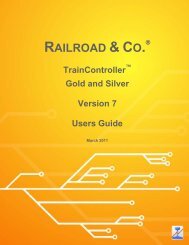Download - Freiwald Software
Download - Freiwald Software
Download - Freiwald Software
You also want an ePaper? Increase the reach of your titles
YUMPU automatically turns print PDFs into web optimized ePapers that Google loves.
X<br />
A typical example of a critical section is a single track line between two stations, which<br />
can be traveled in both directions. If there is one or more block between these two stations,<br />
then these blocks should be marked as critical sections. A train, which is about to<br />
leave one of the two stations towards the other station will not leave this station, if it is<br />
not sure, that a block inside the other station is available, i.e. if it is not sure, that it can<br />
leave the critical section on the other side. This prevents trains from deadlock each<br />
other on the single line track between both stations.<br />
There is a specific option, though, that allows trains, that are executing the same schedule<br />
at the same time, to share a critical section. In this way it is possible to queue several<br />
trains heading to the same direction in the same critical section while opposing<br />
trains must wait, until the complete critical section is clear. This allows several trains to<br />
follow each other on a single track line while locking opposing trains.<br />
Critical sections can be assigned to blocks on a per-schedule base or alternatively in the<br />
main block diagram, too. A block that is marked as a critical section in the main block<br />
diagram will be treated as such in all schedules, that contain this block. A block, that is<br />
marked as critical section in certain schedules only will only affect those trains, that are<br />
controlled by this schedule.<br />
In Versions prior to Version 5.0 of TrainController the Dispatcher used a method<br />
based on so called sub-lines and stages to avoid such deadlocks. These methods are superseded<br />
by the more flexible concept of critical sections. Data files imported from an<br />
earlier version of the software are converted accordingly, i.e. stages and sub-lines contained<br />
in such data files are converted to critical sections.<br />
The Train Guidance System<br />
The Usage of blocks, routes and schedules can be restricted to certain engines, trains or<br />
train groups. In this way it is possible to ensure, that certain schedules are only started<br />
with passenger trains or to avoid, that electric engines enter tracks without overhead cable.<br />
This feature can also be used to make sure, that trains automatically entering a hidden<br />
yard are directed to tracks, which are long enough to hold the train.<br />
If no engine or train is explicitly specified as permitted train, then the block, route or<br />
schedule can be used by all trains.<br />
A schedule can only be started when a train can be found on a block of this schedule<br />
and this train has the permission to use this schedule.<br />
If you want to define home blocks for certain trains, e.g. in a hidden yard, then assign<br />
these trains to their desired home blocks as permitted trains. As a consequence only<br />
207










